Discover Colors That Enhance Your Sleep Quality
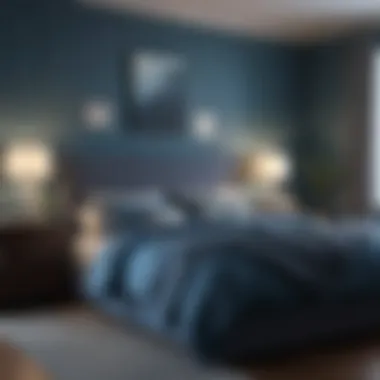

Intro
When it comes to achieving a good night’s sleep, countless factors play a role. From the mattress firmness to room temperature, every detail counts. One of the most overlooked elements is color. The hues in your environment can profoundly impact your mental state and, consequently, your ability to unwind.
Imagine walking into a room painted in bold reds or bright yellows. Instead of feeling relaxed, you might find your heart racing. On the flip side, soft blues and muted greens often evoke calmness. This guide will delve into how specific colors can pave the way for peaceful evenings, allowing homeowners and design enthusiasts to transform their spaces into havens of rest.
Key Insights and Trends
The Psychology of Color
Color is not just a matter of preference; it carries emotional and psychological weight. Studies show that certain shades can elicit specific feelings. For instance, blue tones are associated with tranquility and can reduce anxiety levels. This makes them ideal for bedrooms, where serenity is essential.
Shades of yellow, while cheerful, can be overstimulating when used excessively. Homeowners might consider painting an accent wall instead of saturating an entire room with it. It’s all about striking a balance — utilizing color to foster a smoother transition into sleep rather than a jarring wakefulness.
Current Trends in Interior Design
As more people prioritize mental well-being, the trend toward creating serene environments is on the rise. Color palettes are shifting away from vibrant, loud colors to softer, more muted tones. Here are some current trends in color selection for sleep spaces:
- Earthy Neutrals: Tans, beiges, and soft browns create a comforting, grounded atmosphere. These colors invite a sense of warmth without overwhelming the senses.
- Cool Blues and Greens: Shades resembling water and nature contribute to that peaceful vibe. They can help lower blood pressure and reduce stress.
- Pastel Shades: Soft pinks, lilacs, and mint greens are making a comeback, offering a gentle touch that’s both soothing and pleasing to the eye.
"Color has been shown to affect our mood; choosing the right hues in the bedroom can make all the difference in the world."
Popular Color Combinations
Mixing and matching colors can yield beautiful results if done right. Some harmonious combinations to consider for a sleep sanctuary include:
- Soft blue paired with warm grey for balance.
- Pale green with cream accents to evoke nature’s calmness.
- Dusty rose combined with light beige to add warmth without distraction.
Practical Tips and How-To Guides
Step-by-Step Guide to Choose Bedroom Colors
Choosing the right colors requires some thought. Here’s a simple process to guide you:
- Assess Your Space: Take note of existing furniture and decor. What colors are prevalent? Consider how those colors can influence your new palette.
- Test Paint Samples: Before committing to a color, apply samples on your walls. Observe how the color changes with different lighting throughout the day.
- Incorporate Accents: Think about integrating small elements (like bedding or curtains) in complementary colors to create depth.
- Avoid Overstimulation: Stay away from overly vibrant colors. Stick to calm, muted shades that promote relaxation.
Creating a Relaxing Bedroom Environment
Beyond just color, consider other factors to enhance sleep quality:
- Declutter: A clean and tidy space contributes to mental calmness.
- Lighting: Use soft, warm lamps instead of harsh overhead lights.
- Texture: Incorporate soft textiles like cotton or linen for bedding to feel snug and cozy.
By understanding the psychological effects of colors and how they can create an inviting environment, individuals can navigate toward better sleep and well-being. Transform your space, and you might just find yourself drifting off more easily into slumber.
The Psychology of Color
The intersection of color and psychology is more than a mere coincidence; it plays a momentous role in our everyday lives, especially in environments we inhabit, such as our bedrooms. When it comes to sleep, colors can be the unsung heroes, shaping our moods and affecting our overall sense of tranquility. Understanding how colors work on a psychological level can empower homeowners and design enthusiasts to curate their spaces in ways that enhance relaxation and foster restful sleep.
Understanding Color Perception
Color perception is the way our brains interpret different wavelengths of light, giving rise to a myriad of hues we see around us. This perception can vary from person to person, influenced by factors such as culture, personal experiences, and even individual psychology. For instance, while one might find green to be soothing and calming, another could associate it with envy or frustration.
When selecting colors for sleep environments, it’s important to remember that the context in which a color is viewed can significantly alter its perceived impact. A shade of blue may evoke feelings of serenity when painted on walls, yet when it spars with bright oranges in décor, those feelings could transform into discord. The key is to choose hues that resonate positively with your personal experiences and comfort.
How Colors Affect Mood and Emotion
Colors have a profound ability to evoke emotions and feelings that can influence our mental states. Here are notable examples:
- Blue shades often instill calmness, mirroring the sky or ocean. Shades like light blue can lower blood pressure and slow the heart rate, providing a serene backdrop for sleep.
- Green tones are tied closely to nature, symbolizing tranquility and balance. The soft green of sage or seafoam can remind one of a gentle breeze rustling through leaves, creating a peaceful atmosphere conducive to slumber.
- Neutrals, such as soft grays and warm beiges, create understated elegance and simplicity. These colors do not demand attention but instead serve to ease the mind, allowing for relaxation.
"Colors are the smiles of nature." –Leigh Hunt
Conversely, there are colors that can stimulate or overwhelm the senses. Bright yellows and bold reds can provoke excitement, stirring up energy rather than restfulness. Knowing whether a color uplifts or weighs down the mood is crucial for creating a spaces that invites sleep.
To summarize, the psychology of color in relation to sleep isn’t merely about aesthetics; it’s about harnessing the power of color to craft an environment that encourages rest and relaxation. Through intentional color selection, homeowners can shape their sleeping quarters into sanctuaries for better quality sleep.
The Science Behind Sleep and Color
Understanding the relationship between color and sleep is like peeling an onion—layer upon layer reveals fascinating insights. In this section, we explore how colors not only set the tone for our environments but they also hold significant influence over our sleep patterns. Understanding these connections is fundamental for anyone seeking to enhance their bedtime routine or improve their sleep quality through aesthetic choices.
The Role of Light in Sleep
Light plays a crucial part in regulating our sleep cycles, often determined by both natural and artificial sources. The sun's rays in the morning signal our bodies to wake up, while subdued light at night urges us to wind down. The type of light we experience, especially in the evening, can directly affect melatonin production, a hormone regulated largely by light exposure.
For instance, bright white light, similar to that emitted by electronic devices, can trick our brains into thinking it’s still daytime. This might lead to a delay in sleep onset and affect sleep quality. On the contrary, softer, warmer light tones, like gentle yellows or soft whites, can create an atmosphere more conducive to relaxation.
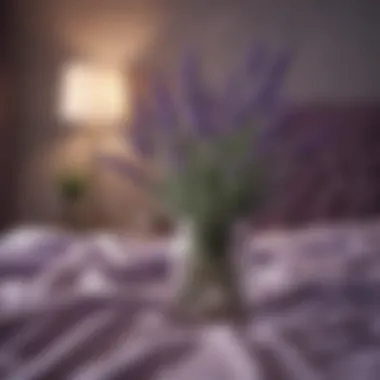
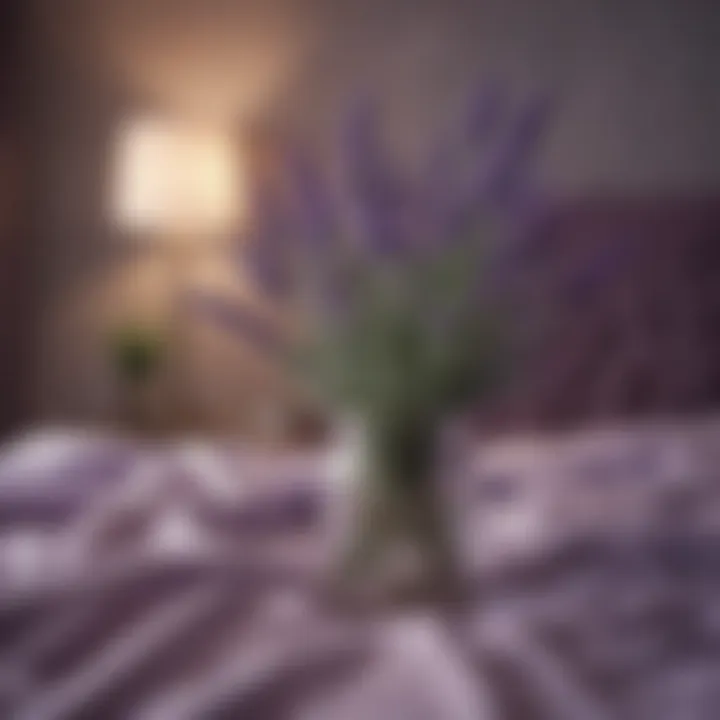
To sum it up, the choices homeowners make with their lighting—in both intensity and color—play a pivotal role in establishing an inviting sleep environment.
Biological Rhythms and Color Impact
Biological rhythms, often referred to as circadian rhythms, are internal processes that follow roughly a 24-hour cycle. These are influenced by external cues, primarily light but also colors. Colors produce varying psychological and physiological responses, affecting our perception of time and wellbeing.
Consider this: when you walk into a room painted in cool pastels versus one draped in vibrant hues, your brain reacts almost instantly.
- Cool colors, such as blues and greens, promote a sense of calm. They contribute to lowering heart rates and foster feelings of tranquility, thereby aiding the transition from wakefulness to sleep.
- In contrast, warm colors, like red and orange, can invigorate and energize the mind, potentially leading to heightened feelings of alertness. This is where the challenge lies—while you may want your space to be inviting, it's essential to be mindful of the colors used in a bedroom setting.
In personalizing your color choices, consider how specific shades resonate with you. For example, someone might find that a calm seafoam green lulls the mind into a restful state, whereas someone else might prefer the soothing effects of pale blue.
As color can impact mood and emotion, understanding one’s individual response to colors enhances the ability to craft a peaceful sleep space.
"Color does not add a pleasant quality to design—it’s not there for that. It is a form of energy, it serves a purpose that we often overlook."
By acknowledging the biological underpinnings of color effects, one can harness this knowledge to incorporate harmonious hues into their sleep environment. This understanding, once translated into the physical realm of bedrooms and relaxation spaces, can create a haven for restful sleep.
Calming Colors for Better Sleep
Creating a space conducive to rest involves more than just the mattress your choose or the pillow's fluffiness. The colors that surround you play a significant role in setting the mood for relaxation and sleep. Calming colors can have soothing effects on your mind and body, helping to reduce stress and anxiety that often disrupt a good night’s sleep. It’s interesting how simply changing the hue of your walls or bedding can foster a more tranquil environment, promoting a more peaceful slumber. This section delves into shades that not only beautify a room but also contribute to enhanced sleep quality.
The Effect of Blue Shades
Dark Blue
Dark blue is a color that resonates with many. It often evokes feelings of calmness and serenity reminiscent of a clear night sky. This deep hue helps create a tranquil environment, making it a popular choice for bedrooms. Its key characteristic is its ability to lower heart rates and promote relaxation. When walls are painted in dark blue, the perception of depth and space is enhanced, creating a cocoon-like feeling that can facilitate better rest.
Though dark blue can absorb light and make a room feel smaller, it works wonders in inducing a peaceful state, as long as it's balanced with other lighter colors in décor.
Light Blue
On the other hand, light blue brings the refreshing feel of a clear spring morning into your space. This shade promotes serenity and has been shown to reduce stress, making it an effective color in sleep environments. Light blue is well-known for creating a soothing atmosphere, encouraging the mind to relax before sleep.
Unique to light blue is its airy quality; it can make even the smallest room feel open and comforting. However, too much light blue without any contrasting colors can sometimes feel too sterile, so it’s wise to integrate other warm tones.
Aqua
Aqua is a delightful mix of blue and green that can foster a sense of tranquility and freshness. This color evokes the feeling of being near water, which is inherently calming. It is popular among homeowners for its vibrant yet relaxing nature. Aqua can create an inviting atmosphere that promotes relaxation after a long day.
One advantage of aqua is its versatility; it blends well with many color palettes, allowing it to fit into various styles. While some might find it unsophisticated in more formal settings, when done right, aqua can add an appealing splash of color that still emphasizes calmness.
The Influence of Green Tones
Sage Green
Sage green is a gentle, muted tone that can significantly impact relaxation and sleep quality. Its soft, earthy feel brings nature indoors, inspiring peaceful thoughts. Sage green is widely regarded for its calming influences, gently soothing the mind after a busy day.
This shade connotes balance and tranquility, promoting harmony in a room. However, it is crucial to balance sage green with other rich colors or neutral tones, as too many muted hues can dull the environment feeling flat.
Seafoam Green
Seafoam green has a refreshing quality, reminiscent of cool ocean breezes. This color can evoke feelings of peace, making it an ideal choice for spaces meant for relaxation. It carries a lightness that helps alleviate tension and stress. Incorporating seafoam green in your bedroom or relaxation area can create a rejuvenating atmosphere.
The unique feature of seafoam green is its softness; it is less stark than many other colors and works well in a variety of lighting. Be careful, though, as too much of it without enough balance can make a space feel idle and lackluster.
Olive Green
Olive green is more than just a sophisticated color; it radiates warmth and coziness. It has calming properties that can help ground and stabilize one's mental space, making it ideal for bedrooms. This hue promotes a sense of safety and security, which is conducive to falling asleep.
One disadvantage of olive green is its potential to darken a space if not carefully used, leading to a heavy atmosphere. Proper lighting and the strategic pairing with lighter colors or patterns can showcase its beauty while maintaining a light, airy feel.
Subtle Neutrals for Relaxation
Soft Grays
Soft grays offer a delicate balance between warmth and coolness, making it an ideal neutral for any bedroom. This color promotes tranquility and helps to ease tension. Soft grays invoke feelings of calm, allowing the space to express subtle elegance.
The key characteristic of soft gray is its versatility; it can harmonize with metallics or rich colors, enhancing its relaxed vibe. A potential concern is that too much gray can make the space feel dreary, but when combined with warm accents, it creates a sophisticated backdrop without overwhelming the senses.
Warm Beiges
Warm beiges are cozy and inviting, fostering a feeling of comfort like that of a cherished blanket. This color can ease the transition from day to night, helping to promote relaxation. Beige in bedrooms can create a welcoming atmosphere, reminiscent of calm deserts or sandy beaches.
One unique feature of warm beige is its ability to exude warmth without being excessively bright. However, if used without sufficient contrast, beige can sometimes feel too plain, losing visual interest.
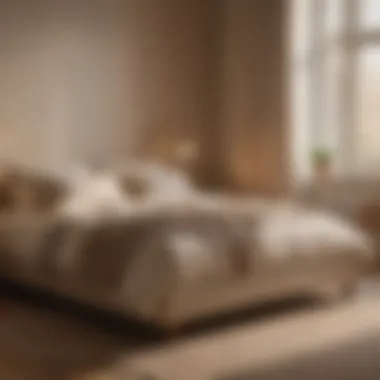
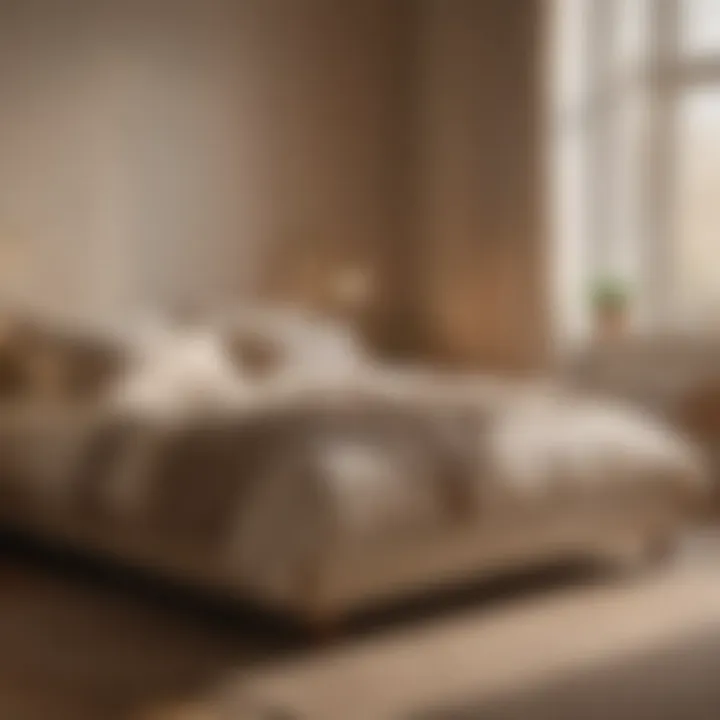
Pale Whites
Finally, pale whites bring lightness to a space, opening it up and making it feel airy. This color promotes clarity and freshness while providing a clean backdrop for other features. Pale white shades are fantastic for fostering an uncluttered mindset, which can lead to better sleep practices.
The unique advantage of pale whites is their transformative quality; they can change the dynamic of a room with just a coat of paint. Yet overusing pale whites without texture or contrasting tones can create a cold feeling, snuffing out the coziness a bedroom should have.
Colors to Avoid in Sleep Environments
Creating a restful sleep space is paramount for achieving quality slumber. However, it’s just as critical to understand which colors can disturb that desired calmness. Not all colors have the same effect on our minds and bodies; some will elicit heightened energy or unease rather than relaxation. So, let's explore colors that should be kept at arm's length when designing a sleep environment.
The Impact of Red and Orange
Red and orange are hues saturated with warmth and energy—think of how a fiery sunset captures attention. While these colors can ignite passion and enthusiasm, they risk disturbing our sleep patterns. This intensity can provoke feelings of excitement. Imagine trying to wind down while your bedroom radiates vibes reminiscent of a lively party or a raucous football match. That’s hardly a recipe for serenity!
On the color wheel, red often symbolizes alertness and urgency, prompting your subconscious to stay awake. Research indicates that these colors can elevate heart rates and blood pressure, making it harder to relax both physically and mentally. In a sleep environment dominated by red or orange shades, one might find it increasingly challenging to enjoy a peaceful night.
Here’s a short rundown on the effects of these colors:
- Red raises alertness and fosters a sense of urgency.
- Orange can feel enthusiastic, but may also feel overstimulating.
So, when it comes to bedding or wall paint, perhaps leave fiery hues for another room—like a bright office or a gym—to ensure tranquility during nighttime.
The Issues with Bright Yellows
Bright yellow may evoke thoughts of sunshine and happiness. But let’s be honest, in a bedroom, that brightness can become overwhelming. Exposure to vivid yellow can lead to increased anxiety and agitation, neither of which belongs in a sleep sanctuary.
In addition, bright yellow is known to cause eye strain. In the dim light of dusk or in the midst of nighttime, a yellow room can feel harsh, making it exceedingly difficult for your body to unwind. The glare from such a color can trigger mental restlessness, leading to an experience that’s anything but soothing.
Here are notable aspects of bright yellow:
- Creates an alert state of mind, making it harder to focus on relaxation.
- Can be perceived as harsh, causing stress rather than comfort.
In summary, to foster a sleeping haven that embraces relaxation and peace, it’s wise to steer clear of colors that might send your mind into overdrive. By eliminating red, orange, and bright yellow from your color palette, you pave the way for serenity and rejuvenation, enhancing your nighttime recovery.
"Choosing the right color is not just a matter of aesthetics; it is a question of health and well-being."
Emphasizing these considerations when flipping your bedroom can significantly impact the quality of your sleep. So, remember that your color choices reflect what kind of rest you’ll get.
Creating a Sleep-Conducive Environment
When it comes to ensuring a good night's rest, creating a sleep-conducive environment is crucial. It's not just about having the right mattress or pillows; the colors in your bedroom play a significant role in how quickly you drift off and how restful your sleep will be. Selecting the appropriate color schemes can influence your mood, reduce anxiety, and set the tone for relaxation.
Color Schemes for Bedrooms
A well-thought-out color scheme for your bedroom can work wonders for your sleep quality. Softer and lighter hues tend to create a calming atmosphere. Shades of blue, for example, have been linked to decreased heart rates and lowered blood pressure. Here are a few color schemes to consider:
- Monochromatic Blues: A palette that varies in shades of blue, from deep navy to soft sky blue, offers a visually cohesive and tranquil environment.
- Earthy Greens: Incorporating greens can evoke a sense of calmness and connection to nature, which is perfect for relaxation.
- Soft Neutrals: Shades of beige, cream, and light gray create a warm sense of comfort without being too stimulating.
By focusing on these soothing color schemes, your bedroom can transform into a refuge from the day's stresses, promoting better sleep.
Integrating Colors in Bedding and écor
The colors you choose for your bedding and décor can amplify the calming effects of wall colors. For instance, a soft blue duvet paired with warm beige throw pillows can create a balanced visual palette that invites relaxation.
- Textiles Matter: Opt for natural fabrics in calming colors. Cotton or linen in shades of sage or pale blue can enhance comfort and serenity.
- Accents and Accessories: Incorporate colored accessories like curtains, rugs, and art pieces that complement the main color scheme. A gentle seafoam-green throw blanket over a cream-colored bedspread can add depth without overwhelming the senses.
The combination of these elements allows for a layered aesthetic that feels cohesive and restful.
The Role of Lighting in Color Perception
Lighting is often a forgotten component in the color equation. The way light interacts with the colors in your bedroom can greatly influence the overall atmosphere. It’s pivotal to consider both natural and artificial light sources:
- Natural Light: During the day, sunlight can enhance the vibrancy of your chosen colors. Light-colored walls may reflect sunshine beautifully, making the room feel open and serene.
- Artificial Light: At night, the type of lighting you choose can alter color perception. Opt for warm light bulbs that emit a soft glow; they not only contribute to a cozy feel but also reduce harsh shadowing that can evoke anxiety.
A simple dimmer switch can allow you to adjust lighting according to your needs, further enriching the sleep-conducive environment.
A well-designed space is not just about aesthetic appeal; it's about crafting an atmosphere that promotes peace and restfulness, essential for a good night's sleep.
By considering these aspects, you can truly enhance your sleeping area, paving the way towards restful nights and refreshing mornings.
Cultural Perspectives on Color and Sleep
Understanding how different cultures perceive color can provide valuable insights into creating a soothing sleep environment. Colors are not merely a visual phenomenon; they carry meanings and associations rooted deep in cultural traditions. By recognizing these perspectives, one can select hues that resonate more profoundly, fostering a better atmosphere for sleep. The considerations around cultural views on color offer a rich landscape where personal preferences and communal beliefs intertwine, which can significantly influence restfulness.
Traditional Views on Sleep Colors
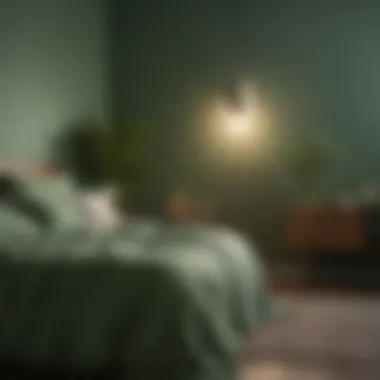

In many ancient societies, certain colors were associated with tranquility and rest. For instance, in various cultures around the globe, shades of blue were favored for sleeping quarters, believed to evoke feelings of calm and serenity. Ancient Egyptians, for instance, utilized blue frescoes in their tombs to mimic the tranquility of the heavens, attributed to nighttime peace. Similarly, in traditional Chinese culture, blue is often linked with healing and relaxation, making it a common choice in bedrooms.
Other cultures have viewed green, often symbolizing renewal and safety, as a desirable color for sleep settings. For example, in many agrarian societies, where nature was a core element of daily life, hues reflecting the surrounding landscape brought a sense of belonging and security when nighttime arrived.
Key Takeaways of Traditional Views:
- Blue and green shades often symbolize calmness and safety.
- Cultural practices have historically favored these colors for sleeping areas.
- Understanding local traditions can enhance the bedroom's calming effects.
Modern Interpretations and Trends
As the world has become more interconnected, modern interpretations of color have evolved significantly. Today's design trends often reflect a blend of historical insights and contemporary aesthetics. For instance, a minimalist approach has gained popularity, emphasizing muted palettes that draw on subtle earth tones. Such shades mirror nature, promoting relaxation without overstimulation.
Recent studies have also pointed to the psychological impacts of color. Warm, soft tones like pale peach or soft lavender have been embraced as effective in promoting a soothing sleep environment, diverging from some of the more traditional choices. These shades are often perceived as nurturing and comforting, suitable for modern sensibilities, particularly in urban settings where overstimulation is a common challenge.
Furthermore, the concept of personalization has risen to prominence, encouraging individuals to adapt color choices to fit their unique experiences and emotions. Popular social media platforms have sparked discussions about the best colors for sleep, fostering a community where shared ideas shape personal choices.
Current Trends Summary:
- A mix of tradition and modern preferences shapes color selection today.
- Earthy and soft tones are popular for their calming effects.
- Personalization and social trends dictate how colors are chosen for sleep spaces.
"Color is the keyboard, the eyes are the harmonies, the soul is the piano with many strings." - Wassily Kandinsky
In summary, appreciating both traditional views and modern interpretations allows for a more nuanced approach to designing sleep environments. Colors are more than just aesthetics; they reflect who we are and where we come from. Understanding these elements can pave the way for creating personalized, calming spaces that support restful nights.
Personalizing Your Color Choices
When it comes to selecting colors in our personal spaces, especially the bedroom, the importance of personalization cannot be overstated. Each individual's taste, culture, and psychological association with color play crucial roles in creating a relaxing environment conducive to sleep. In a world where stress is often an unwelcome companion to our nights, finding colors that not only appeal to our aesthetic sensibilities but also promote calmness is essential. The hue on your walls, the shades of your bedding, and even the accents in your room can all influence how settled you feel as you prepare to sleep.
Colors can evoke different feelings and reactions. For instance, while some find a light lavender soothing, others may prefer a more muted sage. Personalizing your color choices means tapping into your emotional reactions to different shades and selecting those which provide you peace. Involving your personal experiences and preferences into your color designs creates a unique sanctuary that aligns with your subconscious needs for security and tranquility.
Benefits of Personalizing Colors
- Enhanced Relaxation: Tailored color choices can significantly amplify your ability to relax. Knowing you’ve chosen a shade that resonates with you—perhaps the deep greens you associate with a serene forest—can lower anxiety levels.
- Boosted Sleep Quality: Personalization plays a vital role in ensuring that your sleep environment is optimized for rest. As you feel more comfortable in your space, the better your quality of sleep is likely to be.
- Identity Reflection: Your choice of color can be an expression of who you are. It can reflect your personality or even your aspirations, thus creating a deeper connection with your environment.
Considerations in Personalizing Your Color Palette
- Cultural Influences: Different cultures attach various meanings to colors. Understanding these nuances can guide you in choosing the right shades. In some cultures, blue symbolizes peace, while in others, it may carry different associations.
- Light and Space: The light in your bedroom can influence the way colors appear. A north-facing room may benefit from warmer shades to counteract coolness, while south-facing rooms might thrive in cooler tones. 🛏️
- Trial and Error: It’s beneficial to try out different colors. Paint samples can be a good way to see how a color feels at different times of the day. This trial phase allows flexibility and a chance to discover what truly works for you.
"Choosing the right colors for your sleep environment involves both science and personal emotion."
It’s about finding the equilibrium between the psychological effects of color and your own inner response to them. By reflecting on how certain shades impact your mood, you can create an environment that’s not only visually appealing but also promotes a sense of well-being.
Experimenting with Colors for Sleep
Experimentation is a fundamental part of personalizing your space. The process begins by identifying colors that appeal to you emotionally. You might start with traditional calming shades like soft blues or greens and gradually add more unique accents that speak to your personality. Creating a sleep-friendly environment can involve testing various combinations of colors in your decor, such as:
- Trying different shades on a wall before committing
- Using colored light bulbs or lamps to adjust ambiance
- Mixing and matching bedding and accent pillows in various colors to gauge how they affect your mood
Consider setting aside an evening to focus solely on your bedroom space. Switch up some elements, like curtains and throw blankets, to see what might invigorate your relaxation routine.
Documenting Your Experiences
As you play around with different color palettes and elements, documenting your experiences can provide insights that might otherwise slip your mind. Keeping a journal can help track how each change affects your mood and sleep quality. You can note:
- Your initial feelings after introducing a new color
- Changes in your sleep patterns or quality
- Emotional associations that arise in response to color adjustments
- Feedback from family or friends about the new look
This process not only aids in understanding which colors work best but also allows you to revisit successful combinations in future interior design endeavors.
Ultimately, crafting a sleep environment tailored to your unique preferences can set the stage for both restful sleep and a reflection of your personality. Embrace the adventure of color and discover what it can do for you.
Closure and Recommendations
Wrapping up our exploration into the colors that promote sleep, it’s crucial to underscore the profound influence that color can wield over our nightly rest. Colors, subtle as they may seem, play a significant role in shaping our emotions and, consequently, our sleeping environment. By understanding how specific shades can foster relaxation or alter the ambiance of a space, homeowners and design enthusiasts can create sanctuaries that invite restful sleep.
Key Considerations:
- Personal Preference Matters: Recognizing individual preferences in color selection is vital. What calms one person might not have the same effect on another, so aiming for a balance between personal likes and the science of color psychology is beneficial.
- Implementation Within Your Existing Space: You don’t always need a complete overhaul to influence your sleep environment. Simple modifications such as updating linens and using calming hues for walls can suffice.
- Lighting and Its Role: The interplay between color and lighting is paramount. Soft, warm lighting enhances calming colors, while harsher lights can disrupt even the most soothing shades.
For these reasons, a mindful approach to choosing colors in sleeping areas can yield significant benefits for sleep quality and overall well-being.
Summary of Key Points
As we summarize our findings, it’s apparent that:
- Certain colors, such as shades of blue and green, can promote relaxation and sleep.
- Bright and highly saturated colors, like red or orange, can hinder the onset of sleep due to their stimulating attributes.
- Personalizing your color choices based on emotional responses and cultural influences can enhance the sense of comfort.
- Creating a harmonious environment requires attention to both color and lighting, ensuring that the overall vibe is conducive to sleep.
Practical Steps for Implementation
To take action based on the insights gathered:
- Choose Soothing Colors: Aim for soft blues, greens, or neutral tones when painting your bedroom walls or selecting bedding.
- Limit Bright Colors: Avoid bold reds and yellows in spaces where you wish to wind down.
- Employ Layered Lighting: Utilize dimmers and soft light sources to complement calming colors as evening approaches.
- Incorporate Textiles: Select bedding and curtains in your chosen calming colors to reinforce the desired environment.
- Experiment and Document: Try different shades and setups, paying attention to how each influences your ability to relax and sleep.
By thoughtfully selecting colors and harmonizing them with lighting and design, it’s possible to create an inviting sleep oasis that caters to personal needs and preferences.



